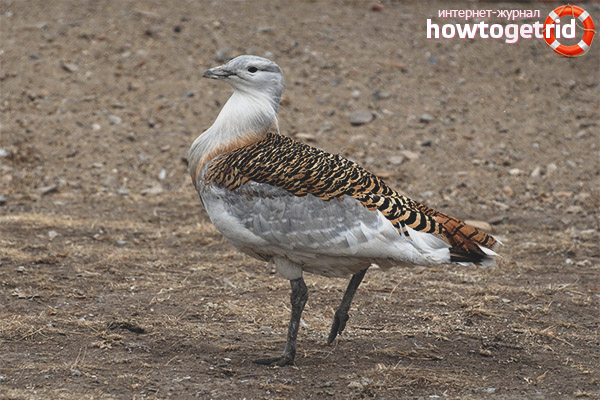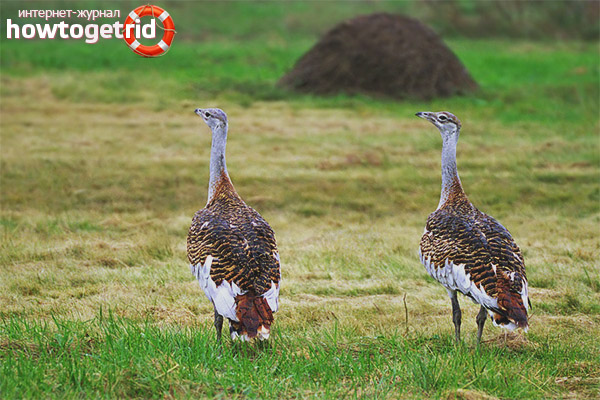The content of the article
The long-represented breed group of birds constantly fell into the hands of hunters. Bustards previously inhabited large packs and were easy prey. Today, it is people, and not predatory animals, who are considered the enemies of these feathered inhabitants. In order to preserve the species, bustards were listed in the Red Book and received their conservation status. Today we will study everything that affects the breed, as well as provide interesting facts and clarify other aspects.
Description
- Otherwise, individuals of the breed group are called dudaks or ordinary bustards. They are considered the largest representatives of similar species when it comes to distribution in the vastness of our homeland. Bustards are large, weighty, according to some external data similar to turkeys. The neck is thick and oval, the chest is wide, sexual dimorphism is clearly visible.
- Females are smaller in weight category grow to 4-8 kg. with a body length of 80 cm. As for the males, they are much larger, grow up to 100 cm. with a weight of 16 kg. From the foregoing, it is clear why hunters love these birds so much.
- Paws with 3 fingers are considered a distinctive characteristic of birds; plumage in this area is completely absent. Therefore, birds move on land so quickly. Despite the large dimensions, they feel great in the air and on the ground. Individuals are fast and agile.
- You can find out what exactly is an individual of the breed group presented to you by plumage. It is colorful and stands out against the general background. The neck and head are painted in gray tones, closer to ashen. And the rest of the body is buffy, with a reddish undertone. Bustards are famous for their streaky transverse pattern, while the chest with the area under the tail is white.
- In terms of the color of the bird's body, the two sexes are not much different. We can say that even professionals find it difficult to identify whether a male or female is in front of their eyes. In spring, males dress up in red plumage, located in the neck. Also, males have bunches of threadlike feathers in the beak area. This coloring lasts until August.
Habitat
- The bird belongs to the steppe species. She prefers not too high vegetation, open meadows, fescue steppes, etc. Previously, representatives of the species lived exclusively in desert places, but due to the economic activities of people, birds slightly expanded their distribution.
- You can meet the breed in the mountains, as well as on the plains. Representatives of the family tolerate temperature extremes, they can be cool for a long time. But as soon as the snow breaks, they try to move south.
- As humanity develops and covers more and more territories, these feathered friends are forced to hide and seek new places. Now they are found in haymaking, in agricultural fields.
Nutrition
- Mixed nutrition, plant or animal food may predominate. It all depends on the habitat, as well as gender and age of the bird. No less importance is given to what kind of food is available in a given season of the year.
- Mature birds love seeds, shoots, foliage, flowers of plants belonging to the family of cabbage, legumes or asters. As for animal food, they feed on larvae and insects themselves, as well as locusts, a bear, grasshoppers, bugs, etc.
- Since these individuals are omnivorous by nature, they adapted not to starve, eating worms, frogs, eggs of birds of a smaller group that do not nest on the top.When bustards gather in large flocks, they begin a full-fledged hunt for rodents. However, little chicks do not eat so diverse, they are given ants and larvae.
- Birds need water, so they often settle near water sources. They can eat snow in the winter season to quench their thirst, and in summer during drought they fly in packs to a watering place.
Propagation Features
- An interesting feature is the unequal achievement of puberty. So, for example, males become sexually mature at 5 years old, and females at 3-4 years old. Birds have a nesting place to which they fly annually in early or mid spring.
- First, they live in packs, waiting for the soil to dry out. Then mating rites begin, as a result of which all individuals are sent to a special platform. They do not have the peculiarity of forming permanent pairs, each year the male has a different female.
- It is interesting to observe the marriage ceremony, which takes place on a grand scale. If you consider that in everyday life these birds are quiet, then during this period they splash out all the energy. In the morning males show off in front of females, and she should choose one companion.
Interesting Facts
- As soon as the sultry days come, the representatives of birds in question lie on the ground and open their beaks wide. They begin to breathe heavily. Moreover, their wings are widely spread. The problem is that such individuals are devoid of sweat glands, which regulate body temperature. It is for this reason that the birds are trying to cool themselves on cool ground.
- It is worth noting that the plumage gets wet in such individuals during rain. This phenomenon is considered the most dangerous especially during frosts. The bird simply can not fly up and remains completely defenseless. Often predators take advantage of this situation. The problem is that the bustard does not have glands that produce a special grease, due to which water could slide off the wings.
- It remains interesting that adult individuals who are quite heavy in danger do not fly away, but run away. These birds take off very hard. It is for this reason that they try to escape from danger. Each time, when a bird grows up and is gaining more weight, it takes off less and less.
- Males often gather in flocks and make strange muffled sounds. At the same time, they throw their heads back and inflate the throat sac. At this time, the males spread feathers as widely as possible. Thus, they attract the attention of females. In this period, the males look rather strange and look like a round ball of feathers.
- As you already understood, the presented individuals feed on animal and plant foods. Most often in their diet you can find lizards, insects, various grasses and frogs. With the onset of warm days, birds give preference to plant foods. As soon as the cold sets in, individuals begin to eat animal food.
- It is worth noting that representatives of this species belong to the endangered and rare species of birds. The considered individuals are under protection and are listed in the Red Book. Now everything is being done in order to preserve unique birds. The species of birds began to decline rapidly due to uncontrolled hunting for them. Also, people began to occupy large agricultural areas and apply chemicals.
- The problem is that such birds lay eggs in the fields. Offspring dies with hay mowing. In addition, various predators often attack individuals. Poachers prey on adult bustards. Birds often die from electrical wires and sprayed chemicals in the fields.
- Such birds like to enjoy juicy and tasty grass. For this reason, they often visit agricultural fields. In addition, they destroy crops. Therefore, among farmers, the feathered birds are considered pests.
- Do not forget that these individuals are quite large in size.Moreover, they have a long neck and no plumage on their paws. The plumage often has red and white shades. Because of this color, the birds merge with the terrain. It’s easier for them to hide from predators. In addition, bustards resemble ostriches in some ways, only much less.
- Individuals make nests in the ground in the form of recesses. A female can bring up to 4 eggs. By color, they can be olive or greenish in color with a splash. To build a nest, birds independently dig holes and level the groove with their own bodies. Down they impose dried grass. The female is engaged in egg laying.
Bustards are unique representatives of birds. If they notice the danger during the hatching of the offspring, the bird pretends to be lame and begins to lead the predator to the side. After this, the individual tries to escape from danger. The birds in question became rare and are on the verge of extinction. Poachers continue to hunt them.
Video: interesting facts about the bustard bird












Submit